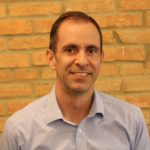Under pressure: Competing forces of historic preservation, density, and sea level rise on Central Avenue

Click the arrow above to hear the full conversation between Russ Robertson of Cap Ex Advisory Group and Catalyst publisher Joe Hamilton.
As sea levels rise, so too will the already-heated debate between St. Pete’s historic preservation interests and the push for more dense development.
If the experts are right, and sea levels rise as expected over the next 50 years, the corridors of the cities that sit highest above sea level will come under increasing pressure. Those same areas already house some of the most concentrated clusters of current and potential historic landmarks in St. Petersburg.

Russ Robertson, founder of Cap Ex Advisory Group
How can a city balance these competing forces, while simultaneously preparing for the realities of climate change and sea level rise? Russ Robertson’s Cap Ex Advisory Group is working to answer those very questions. Cap Ex, based in the Baltimore area, recently opened an office on St. Petersburg’s Central Avenue. The group advises, project manages and guides clients through the regulatory processes around large real estate development projects.
Corridors like Central Avenue are home to many of the historic, street-level elements that make a St. Pete such a walkable, charming and desirable city, but Robertson argues that its geographical location, natural elevation and its “by right” allowed density by city code also makes it a prime candidate for increasingly dense development.
“There’s a high ridge, essentially a dome that’s about 40 ft high at its highest point,” Robertson explained. “From about the door step of the ONE project all the way to about 40th street on the west side of St. Pete, there’s a fairly high region of land mass that’s protected essentially from whatever storm level surge you could predict or whatever sea level rise you could project; upwards of 20-25, even 30 feet, plus.”
“If you put your 50-year hat on for a minute and you think about the longevity of the future of the city of St. Pete, and you want to think about development density in this region, it makes sense to capitalize on two things,” Robertson continued. “The height of the dome, (i.e. it’s protected from sea level rise) and the development density that’s in place today. That represents a little bit of a wrinkle in the discussion about historic preservation interests.”

A map of local landmarks (blue) and potentially eligible property (green) in the Central Avenue Corridor and five blocks North and South of Central.
Cap Ex created a “development density diagram,” basically an exaggerated vertical scale drawing that is 10 times taller than reality. Robertson said that was done in part to allow it to be printed on 8.5 x 11 paper and handed out, but also to show something that is difficult to see when driving down Central Avenue. The diagram takes a cross section of Central Avenue, from the bay to 18th street, graphing the current height of development along the corridor against “by right” and “by hearing” allowed height limits and floor area ratios (FAR) based on city code.
“The development density diagram really shows graphically how underutilized the vertical development density is now, when you look at it, it’s really striking. The existing buildings that line the Central Avenue corridor are short, they’re very short.”

CEAG’s Development Density Diagram. A 10:1 Exaggerated Cross Section Through Central Avenue – Looking North
Robertson believes Central Avenue’s development potential has led to the gobbling up of large swaths of existing properties by developers for prices that, under different conditions, would be seen as outlandish. According to Robertson, those developers are willing to pay the price in hopes of aggregating the sites to capitalize on potentially large-scale developments.
That price tag, however, puts the mom and pop businesses that have called Central Avenue home for decades in jeopardy, as rents rise and businesses like Daddy Kool Records and Kalamazoo Olive Oil Company are pushed out.
“The only thing you can do once you’ve paid $4.5 million for a 10,000-square-foot building is try to raise rents, and the tenants are being caught in the crossfire,” said Robertson.
Mayor Kriseman’s Storefront Conservation Plan has already posed one solution to this ongoing problem, but Robertson’s previous work in Baltimore offers another avenue that could allow the historic preservation and development interests to coexist.
“Leave the one or two story historic fabric of a neighborhood – the part that puts at street level the activity that you want from an urban planning perspective,” Robertson explained. “Leave that exactly where it is and let the development density exist right behind it, just above it, outside of your immediate peripheral vision as you walk up and down say Central Avenue or any of the other major streets that you would identify as really truly charming in St. Pete.
“The preservationist in me says let that stay, but let’s also capitalize on the development density potential that exists around it, behind it, beside it, above it. and essentially create two St. Petes: an above and a below.
“There’s a lot that goes with density – some good, some bad,” said Robertson. “There’s no good answer. The answer is that both parties are right for different reasons.”


Lin Shambaugh
May 22, 2019at6:36 pm
What is happening in DT st. Pete is happening is affluent, historical neighborhoods … these developers are coming in and paying top dollar for any house that’s on multiple lots, bulldozing them, and putting up cheap, cookie-cutter, crap houses 3 feet on top of each other! The city would rather get tax dollars on four $500,000 homes then keep a neighborhood Historical, traditional Saint Petersburg and aesthetically pleasing! What the city just did with the old Doc Webb house is a perfect example and makes me sick!
I med into the Affluent Allendale Terrace because of its charm, the large lot sizes, and Saint Petersburg Vibe. I did NOT more into this neighborhood 30 years ago so that the house 🏡 down the street looked just like the one in Jordan park, or 34th Street and on top of each other 🏡 🏡 🏡 🏡! All the same, all on top of each other and all cheap-ass, crap houses!!
David Watson
May 14, 2019at3:19 pm
I don’t understand the attempt at connecting a second level of development on the highest elevation ground in St. Petersburg to historical preservation. I’m all for the idea advanced in this article but the climate change premise makes the idea absurd. If the sea level is rising so as to make Central Avenue the only place to build, I submit that St. Petersburg will need to be abandoned, not expanded vertically or otherwise.
Bill Vogel
May 14, 2019at3:05 pm
Please cut the baloney with sea levels rising.
Climate expert and big phony Al Gore said Miami would be underwater in 2016.
Still waiting Al!